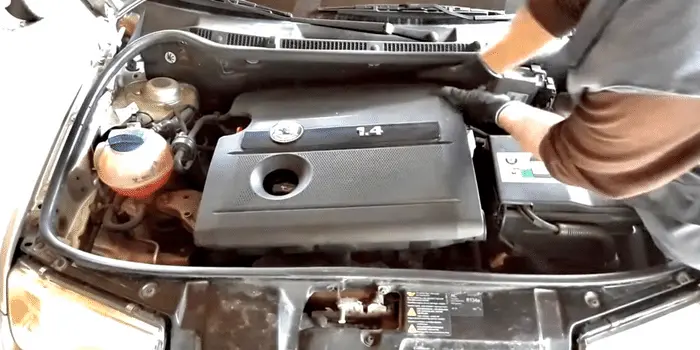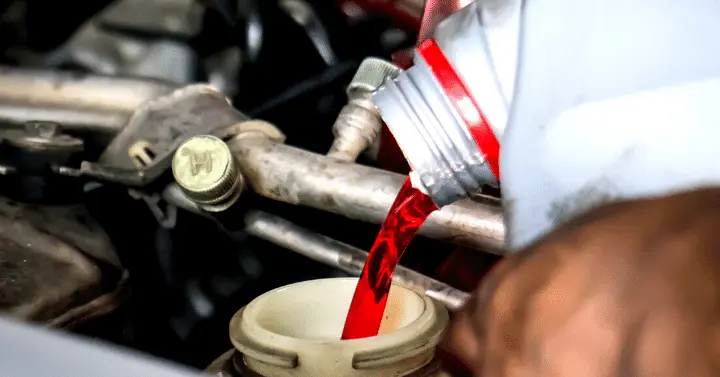Automobiles require frequent checking of transmission fluid. In terms of Jeep Cherokee, you should check it every 3,000 miles or 90 days to get a smooth gear shifting experience while driving.
Irregularity with this maintenance can result in transaxle fluid leaks. So, it’s essential to know how to add transmission fluid Jeep Cherokee.
Unlike other vehicles, Cherokee requires ATF4 or Automatic Transmission Fluid 4. In order to errorless fluid transmission, get your jeep on level ground. Otherwise, the fluid will splatter all over the place.
The guide covers both — how to check and change the transmission fluid without getting help from a mechanic. Make sure to read every step carefully.
What Are the Symptoms of Low Transmission Fluid?
If your vehicle is suffering problems with the low transmission fluid, it’ll show some indications before causing a severe problem. These are –
Engine Noise
It’s the most common symptom triggered by low transmission fluid. Your vehicle engine will generate unusual sounds. However, the noise may differ depending on the vehicle type and gear system.
For example, in terms of auto gear vehicles, you’ll notice a humming sound. On the contrary, cars with a manual gear system will produce loud or clunky noises.
Leakage
Any vehicle’s fluid leaking issue indicates that it’s running on low transmission fluid. Sometimes, you may witness the red fluids leaking from the vehicle while driving or parked.
Burn Smell
Well, transmission fluid can cause a burning smell due to overheating issues. Low fluid isn’t always the culprit among other symptoms, but there is a possibility. And if you drive without identifying and fixing the problem, it’ll worsen.
Slow Gear Shifting and Slipping
Because of the inadequate fluid status, you’ll notice the gear can’t hold when you shift to the next. Sometimes, it may hold but will take an unusual time to shift. This is nothing but a sign of low transmission fluid.
Warning Light
Though the warning indicator on the vehicle’s dashboard doesn’t only light up due to the low fluid level; sometimes, it can be one of the reasons.
Depending on your vehicle’s model, the engine light or the dashboard indicator shows a low fluid warning.
Bad Acceleration
A low fluid level often negatively impacts your automobile accelerator, resulting in slow pick-up. It’s related to the transmission and can cause major problems if not repaired in time.
How to Check and Refill Transmission Fluid in a Jeep Cherokee?
Since the fluid will remain hot long after driving, perform this procedure only after the engine has cooled down completely. Fluid temperature can exceed up to 350-degree Fahrenheit in a hot transaxle. Put on protective gloves and take all necessary precautions to prevent burns.
Note: Improper automatic transmission fluid could result in transaxle malfunctions or failure. Before proceeding, check the manufacturer’s website to find the correct ATF.
Required Tools
- Dipstick (must measure 140 mm from the bent)
- Floor Jack
- Jack Stands
- Drain Pan
- Vehicle Handpump Tube
Step 1: Raising the Jeep
Hop in the vehicle and pull the hood release by the kick panel. Pull the safety latch forward. Then raise the hood and put on the parking brake.
Choke the rear wheel with a choker or car stopper to prevent the vehicle from rolling. Loosen the front wheel lug nuts.
Place a floor jack under one side of the vehicle, positioning it under the reinforced frame area. Then raise the front of your jeep.
After lifting at your required height, support it with a jack stand under the notched area of the rocker panel seam and remove the floor jack.
If lifting both sides, place the floor jack on the opposite area of the vehicle and put a second jack stand after raising the vehicle.
“When raising both sides of the Jeep Cherokee, ensure either side are level with the ground.”
Step 2: Remove Wheel and Engine Cover
Now, unscrew the lug nuts of the left front wheel to remove it. Then turn the steering wheel to the left.

Loosen all the screws around the under-engine cover, both front and rear. Then working from one to another, remove the fasteners and lower the under-engine cover from the vehicle.
Step 3: Drain Transmission Fluid
With the engine off, loosen the drain plug. Place a large drain pan underneath it and remove the drain plug, allowing the fluid to drain.
Once the liquid has drained, clean the drain plug and the area around the plug opening area. Now reinstall the plug. Make sure to tighten the plug with 26 ft-lbs torque.
Put out the drain pan underneath and measure how much fluid is drained. It’ll be required during the transmission fluid refilling process.
Step 4: Refill Transmission Fluid
Working through the left-front wheel well, remove the check-fill plug from the rear of the transaxle.
Insert a vehicle handpump tube into the check-fill plug opening and pump the new transmission fluid equal to the amount of drained fluid you collected earlier.
Remove the filling tube. Clean the check-fill plug and install it in the transaxle. Make sure to tighten it securely.
Step 5: Inspect Fluid Temperature
Start the engine and keep it idle for a minute. Then slowly move the shift lever to each gear position to end parking again. Pause for 2 seconds in each post.
Not get out of the car and remove the check-fill plug from the transaxle. Get back inside the vehicle and access the transmission fluid temperature settings using the instrument cluster.
Press and hold the “OK” button on the left side of the steering wheel. It may take up to 5 seconds to display the vehicle’s info.
“The instruction is based on Jeep Cherokee 2014 version 6 model. Depending on your model, the position of the instrument cluster may differ but should work in the same manner.”
Use the up or down arrow on the cluster until you find the “Trans. Temp.” option.
Step 6: Balance Fluid Level and Temperature
Now return to the left-front wheel. Insert the dipstick tube into the transmission fluid level check-fill hole. Then pull it out and inspect the fluid level from the bottom of the dipstick.
You may need to do this multiple times to get an accurate fluid level reading. Compare the measurement reading dipstick tool with the transaxle fluid temperature reading you see on the instrument cluster panel. You should match both readings according to the fluid level chart given below.
| Fluid Temperature (Unit) | Minimum Level (mm) | Maximum Level (mm) | Required Level (mm) |
| 212° | 27 | 34 | 31 |
| 194° | 23 | 30 | 27 |
| 176° | 21 | 27 | 25 |
| 158° | 18 | 24 | 23 |
| 140° | 17 | 23 | 20 |
| 122° | 13 | 19 | 16 |
To match the chart, add the necessary amount of transmission fluid afterward. Once the fluid level is correct, following the chart, reinstall the check-fill plug and tighten it to the 17 ft-lbs torque.
Step 7: Finishing Up
When you match the proper settings without any leak, place the under-engine cover in the position and align the fastener openings. Then reinstall the cover screws and secure them required.
Install the left front wheel and tighten the lug nuts. The best torque setting for these lug nuts is around 100 ft-lbs.
Raise one side of the vehicle with the floor jack, remove the jack stand, and lower that side to the surface.
Afterward, do the same on the other side of the vehicle to remove the 2nd jack stand. Finally, remove the choke from the wheels.
Note: Recheck under the vehicle for transmission fluid leaks during the first few trips.
How Long Can You Drive a Car with Low or Zero Transmission Fluid?
Unfortunately, there is no easy answer to that question. It depends on a number of factors, including the type of car you’re driving, its condition, the severity of the one touch leak (if occurred), and the outside temperature for overheating problems.
Among them all, the gear system plays the biggest role. In the case of manual gear, you can drive up to 10-15 miles without transmission fluid.
However, in terms of auto gear, vehicles won’t start without transmission fluid as these are manufactured in that way. You can drive any vehicle on low fluid, but it would be unwise to do so.
How Often Should You Change Transmission Fluid?
There are many myths among vehicle owners regarding the time of changing transmission fluid. Manual vehicles require fluid replacement more often than automatic ones.
Depending on the vehicle brand you’re riding on, the fluid changing interval may vary. However, it should be 30,000-60,000 miles in the case of manual automobiles.
The good thing is fluid consumption in automatic vehicles, is relatively efficient. You can drive 60k to 100k miles before replacing the transmission fluid.
But the above intervals between fluid change is only applicable in the general sense, considering average driving habit.
If you’re a heavy-duty or commercial user, you should lower the period to 15k miles if it’s a manual car. And if it runs on auto gear, 30k miles should be a suitable timeline before changing the fluid.
Frequently Asked Questions
1. How do you add transmission fluid to a 2011 Jeep Grand Cherokee?
Adding transmission fluid in all 2011 to 2020 Grand Cherokee models is somewhat the same. They all require ATF4. First, you need to uncover the engine. Then drain residue fluid from the tank and refill it with the same amount of new transaxle fluid. Make sure to match the temperature depending on the fluid level.
2. Where do you add transmission fluid in Grand Cherokee?
In Grand Cherokee, the location of the transmission fluid tank can be identified with the stock dipstick placement. Open the hood release. The transmission dipstick looks like an oil dipstick – an orange or yellow handle. Pull it out to find the whole where you should add the transmission fluid.
Wrapping Up
That was all on how to add transmission fluid Jeep Cherokee. Even though you maintain the interval, sooner or later, you may witness fluid leaking issues, which will cause an unanticipated gear shifting experience. In that case, you must get your vehicle to the nearby service center.

